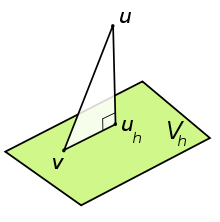- Céa-Lemma
-
Das Céa-Lemma, oft auch Lemma von Céa oder Céas Lemma genannt, ist ein mathematischer Satz aus der Funktionalanalysis. Es ist grundlegend für die Fehlerschätzung von Finite-Elemente-Näherungen von elliptischen partiellen Differentialgleichungen. Das Lemma trägt den Namen zu Ehren des französischen Mathematikers Jean Céa[1], der es in seiner Dissertation 1964 bewies.
Inhaltsverzeichnis
Formulierung
Voraussetzungen
Sei V ein reeller Hilbertraum mit der Norm
 . Sei
. Sei  eine Bilinearform, die
eine Bilinearform, die- beschränkt (äquivalent dazu stetig), d. h.
 für eine Konstante C > 0 und alle
für eine Konstante C > 0 und alle 
- und koerzitiv (häufig auch stark positiv, V-elliptisch), d. h.
 für eine Konstante α > 0 und alle
für eine Konstante α > 0 und alle 
ist. Sei weiter
 ein beschränkter linearer Operator.
ein beschränkter linearer Operator.Problemstellung
Betrachte das Problem, ein
 mit
mit für alle
für alle 
zu finden. Betrachte nun das gleiche Problem in einem Unterraum
 , d.h. es ist ein
, d.h. es ist ein  zu finden mit
zu finden mit für alle
für alle  .
.
Nach dem Lemma von Lax-Milgram gibt es für beide Probleme eine eindeutige Lösung.
Aussage des Lemmas
Sind die obigen Voraussetzungen erfüllt, dann besagt das Céa-Lemma:
 .
.
Dies bedeutet, dass die Approximation der Lösung uh aus dem Unterraum Vh nur um die Konstante
 schlechter ist als die beste Approximation für u im Raum Vh, sie ist quasi-optimal.
schlechter ist als die beste Approximation für u im Raum Vh, sie ist quasi-optimal.Bemerkungen
Mit einer symmetrischen Bilinearform verkleinert sich die Konstante auf
 [1], der Beweis ist weiter unten angegeben.
[1], der Beweis ist weiter unten angegeben.Das Céa-Lemma gilt auch für komplexe Hilberträume, indem eine Sesquilinearform
 statt der Bilinearform verwendet wird. Die Koerzivität wird dann zu
statt der Bilinearform verwendet wird. Die Koerzivität wird dann zu  für alle
für alle  (man beachte den Betrag um a(v,v)).
(man beachte den Betrag um a(v,v)).Die Approximationsgüte des Ansatzraums Vh bestimmt den Approximationsfehler
 stark.
stark.Sonderfall: Symmetrische Bilinearform
Die Energienorm
In vielen Anwendungen ist die Bilinearform a symmetrisch, also a(v,w) = a(w,v) für alle v,w in V. Mit den Voraussetzungen des Céa-Lemmas ergibt sich, dass a ein Skalarprodukt von V ist. Die implizierte Norm
 wird Energienorm genannt, weil sie in vielen physikalischen Problemen eine Energie darstellt. Diese Norm ist äquivalent zur Norm
wird Energienorm genannt, weil sie in vielen physikalischen Problemen eine Energie darstellt. Diese Norm ist äquivalent zur Norm  des Vektorraums V.
des Vektorraums V.Das Céa-Lemma in der Energienorm
Aus der Galerkin-Orthogonalität von u − uh mit Vh und der Cauchy-Schwarzsche Ungleichung ergibt sich
 für alle v in Vh.
für alle v in Vh.
Somit lautet das Céa-Lemma in der Energienorm:
 für alle v in Vh.
für alle v in Vh.
Man beachte, dass die Konstante
 auf der rechten Seite verschwunden ist.
auf der rechten Seite verschwunden ist.Das bedeutet, dass die Unterraum-Lösung uh die beste Approximation der Lösung u bezüglich der Energienorm ist. Geometrisch lässt sich uh als Projektion bezüglich a von u auf den Unterraum Vh interpretieren.
Folgerungen
Damit lässt sich die schärfere Schranke für symmetrische Bilinearformen für die gewöhnliche Norm
 des Vektorraums V zeigen. Aus
des Vektorraums V zeigen. Aus für alle v in Vh
für alle v in Vh
folgt
 für alle v in Vh.
für alle v in Vh.
Beweis
Der Beweis ist nicht lang und führt die Notwendigkeit der Voraussetzungen vor Augen.
Galerkin-Orthogonalität
Die in der Problemstellung gegebenen Gleichung a(u,v) = L(v) für alle
 und a(uh,v) = L(v) für alle
und a(uh,v) = L(v) für alle  werden voneinander abgezogen, was wegen
werden voneinander abgezogen, was wegen  möglich ist. Die resultierende Gleichung lautet a(u − uh,v) = 0 für alle
möglich ist. Die resultierende Gleichung lautet a(u − uh,v) = 0 für alle  und wird Galerkin-Orthogonalität genannt.
und wird Galerkin-Orthogonalität genannt.Abschätzung
Die Bilinearform a ist koerziv
Addition von 0, sei

- = a(u − uh,u − vh + vh − uh)
Mit Bilinearität von a
- = a(u − uh,u − vh) + a(u − uh,vh − uh)
Der zweite Term ist 0 wegen der Galerkin-Orthogonalität, da

- = a(u − uh,u − vh)
Die Bilinearform ist a stetig
Die Gleichung kann durch
 geteilt werden. Da vh beliebig aus Vh gewählt ist kann auch das Infimum gewählt werden, wodurch wir die Aussage erhalten.
geteilt werden. Da vh beliebig aus Vh gewählt ist kann auch das Infimum gewählt werden, wodurch wir die Aussage erhalten.Literatur
- D. Braess: Finite Elemente - Theorie, schnelle Löser und Anwendungen in der Elastizitätstheorie. 4. Auflage. Springer, 2007, ISBN 978-3-540-72449-0 (Kapitel II §4.2 und Kapitel III §1.1).
- Jean Céa: Approximation variationnelle des problèmes aux limites. 14, Nr. 2, 1964, S. 345–444 (Original-Arbeit von J. Céa, PDF, 5 MB).
Einzelnachweise
- ↑ a b E. Emmrich: Gewöhnliche und Operator-Differentialgleichungen - Eine integrierte Einführung in Randwertprobleme und Evolutionsgleichungen für Studierende. 1.Auflage. Vieweg+Teubner, 2004, ISBN 978-3-528-03213-5, Seite 112
- beschränkt (äquivalent dazu stetig), d. h.
Wikimedia Foundation.



